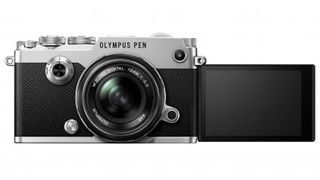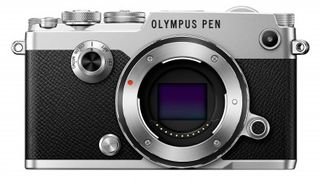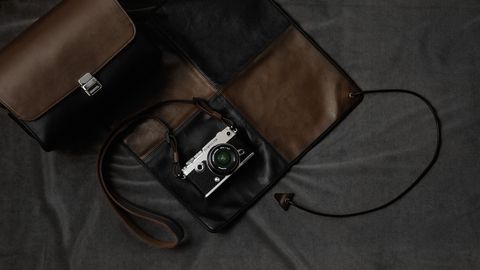TechRadar Verdict
The PEN-F looks and feels great, giving you plenty of easy to access control as well as lots of customisation options. It has a host of clever features and while images don't always look as sharp as from some other cameras, it produces high quality results.
Pros
- +
High quality electronic viewfinder
- +
New 20Mp sensor
- +
Build quality and controls
Cons
- -
Small, fiddly buttons on the back
- -
Expensive next to other Olympus cameras
- -
High Res Shot mode of limited use
Why you can trust TechRadar
Olympus has two lines of Micro Four Thirds compact system camera (CSC); PEN and OM-D, with the OM-D series being the more 'serious' of the pair and aimed at enthusiast photographers. Both ranges have a distinct retro style with the OM-D cameras resembling traditional SLRs and the PEN models having a more rectangular shape like the 1960's series of Olympus PEN film cameras.
The PEN-F comes in at the top of the current PEN line-up and has a 20 million pixel Four Thirds type sensor – 4million more pixels than previous PEN models like the E-PL7 and E-P5.
Until now, one of the most distinguishing features between the two lines has been that the OM-D cameras have a viewfinder built-in whereas the PEN models don't. The PEN-F changes that, having an OLED electronic viewfinder with 2.36 million dots integrated into the body.


It's a significant upgrade that makes it easier to compose images in bright sunlight. And because the camera is held against your face, it's also usually held steadier when you're looking into a viewfinder, which could result in sharper images. However, the PEN-F also has Olympus's excellent 5-axis image stabilisation built-in and this is claimed to extend the safe hand-holding shutter speed by up to 5EV – that's the difference between 1/500sec and 1/15sec. The stabilisation system also operates in video mode to help smooth some of the fine jitter that occurs when holding a camera.
Naturally, there's also a screen on the back of the camera that can be used for composing and reviewing images. This is a 3-inch LCD with 1,037,000 dots and, as usual with Olympus CSCs, it's touch-sensitive. More good news is that the screen is attached via an articulating bracket so it can be flipped out and angled up or down for easier viewing from high or low angles when shooting in upright or horizontal format. It can also be spun round for selfie shooting.


Olympus says the PEN-F is designed for spontaneous everyday street photography without a tripod, and to back this up it has a maximum continuous shooting speed of 10fps. However, if you want focus, exposure and white balance to adjust between shots you'll have to drop the rate to 5fps. There's also an 81-point autofocus system which, despite relying on a contrast detection system rather than the hybrid AF system in Olympus's more advanced OM-D models, is claimed to offer the shortest lag between pressing the shutter button and taking the picture of any camera in its category (at the time of announcement on 27th January 2016).
Operational speed is aided by Olympus's Eye Detect AF system and touch-panel point focusing. In a change to previous systems, Olympus has now locked the spot metering to the active autofocus point for more reliable spot metering, and manual focus is made easier with a focus peaking option – this outlines edges within a scene when they peak in contrast and are therefore in focus.
With these speed credentials in mind it may seem odd to some that the new camera also has the High Res Shot mode first seen on the OM-D E-M5 Mark II, which is a 'tripod-only' feature. This clever system makes use of the PEN-F's stabilisation system to shift the sensor by half a pixel at a time between shots as it captures eight 20Mp images in a sequence. These files are then merged into a single high-resolution image. With the E-M5 II it delivers 40Mp JPEG images or 64Mp raw files, but on the PEN-F the JPEG image size has been increased to 50 million pixels while the raw files are a whopping 80.6Mp.
It's worth bearing in mind the exposure limitations when using High-Res Shot mode – the maximum shutter speed available is 8 seconds while the minimum aperture is f/8 and the highest available sensitivity setting is ISO 1600.

There's no 4K video option, but the PEN-F can shoot Full HD (1920 x 1080) at a range of frame rates, including 60p, 50p, 30p, 25p, 24p. Keen videographers will be disappointed to learn that there's no microphone or headphone port for better in-camera sound recording and monitoring. Those who are new to video, however, may appreciate Olympus's My Clips feature that makes it easy to record short clips of video that can be arranged in-camera and exported to the memory card with (slightly cheesy) backing music.
Other features without which no Olympus CSC would be complete include a collection of 28 Art Filters and Wi-Fi connectivity. It's possible to customise some of these filter effects by adding a frame or vignette and you can shoot bracketed sequences so you have a collection of images with different effects applied. Helpfully, it's possible to shoot raw and JPEG images simultaneously when using the Art Filters so that you have a 'clean' file for post capture editing.

Amazon Prime Video's disappearing act could point to a future without the service

Tesla Cybertruck suffers new recall for a very scary problem

'The party is over for developers looking for AI freebies' — Google terminates Gemini API free access within months amidst rumors that it could charge for AI search queries
